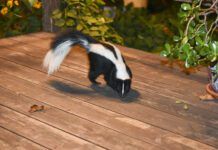We bought Belle as a puppy from a friend, Linda, who is also a very good and conscientious breeder. A couple of Linda’s dogs were notorious for eating sticks and/or other assorted objects. Belle’s mother, in fact, had to have a quarter and a dime surgically removed from her stomach. We like to call that the “not-so cost-effective money retrieval” system! (Linda is also an accountant.)
So, when Belle started finding assorted objects to munch on as well, we joked about it. But we stopped laughing in July of 1996, when she swallowed (whole) a pair of my nephew’s underpants. Later on the same day she ate them, she stood in front of my husband, looking a little green around the gills, and threw them up in one big burp! All the time she was growing, Belle had eaten some pretty nasty things, but this took the cake!
Belle also exhibited a few other strange symptoms. For one, she was a habitual “paw licker,” and would develop “lick granulomas” – not to mention drive me crazy – if I didn’t watch her carefully. And while her appetite for weird things was strong, she was a disinterested eater of dog food. Since coming to us at seven weeks, she had never eaten her dog food with a good appetite; I almost had to force-feed her at times.

I wasn’t really prompted to look further into these conditions, however, until the underwear incident. Shortly afterward, she started to lose weight. When her weight loss reached 15 pounds, I panicked and scheduled an appointment with a veterinarian I sometimes use in Andover, Massechusetts. An endoscopy revealed a blockage that called for immediate surgery. Inside her stomach, they found a hunk of “mixed materials” – a combination of plastic Nylabone, cloth, and other unidentifiable stuff.
After surgery, she recovered fairly well, but still was not eating right. She gained about 10 pounds, but was still all bones. I took her to my regular veterinarian, Dr. Eric Bloomfield of the Northside Animal Hospital, here in Manchester.
Supplement improves situation
Dr. Bloomfield took a look at Belle, listened to her history, and heard me cry for about 10 minutes about not wanting to lose her. Then he left the room and came back with a container of green powder. He said, “Don’t laugh and don’t be afraid. This stuff will help your dog, if you use it!” In the container was Super Blue Green AlgaeTM (Aphanizomenon flos-aquae).
I was sceptical, but Dr. Bloomfield was so serious, I decided to give it a try, thinking all the while, “Yuck, if I don’t like the look of it, how will I get Belle to eat it?” I disguised it in several ways, rolling it up in raw hamburger or cheese.

One day, about a week and a half after giving her the SBGA daily, I heard the sound of a bowl being banged in the kitchen. I usually tune out that sound, as our resident “pork chop” Molly, the Pointer, likes to eat ‘round the clock, and that’s how she says she’s hungry. But there was Molly at my feet! I ran into the kitchen, and who should I behold but Belle, standing in front of her dish, whacking it with her paw!
After placing two cups of dry food in front of Belle (whose motto has always been, “What me? Eat dry food? Never!”), I went into shock when she finished it in four minutes flat.
That was the beginning of a new and improved Belle. Within two weeks she gained another 10 pounds, and almost completely stopped eating “bad” things. About five weeks after starting her on the algae, she weighed 115 pounds, ate three meals a day because she asked for it, and has since had very few episodes of chewing or eating inappropriate items. (The exception has been when she’s experiencing a false pregnancy, then I have to double the SBGA I feed her.) She looks great, her coat is now a shiny, deep steel blue, with no more “brown out.” She also lost her skittishness and is more outgoing. She only licks her paws excessively when she’s stressed; otherwise, that behavior is gone.
I did test the algae several times by removing it from Belle’s diet. Each time her consumption of food decreased within four to seven days. She is now on a maintenance dose, getting 1/3 teaspoon of the algae per meal, and she’s doing great.
Of course, since Belle’s success, I started giving the algae to Molly (the Pointer). Molly has chronic pain from a torn ligament, and I had been giving her ascriptin and phenylbutazone for treatment. She couldn’t play with the big dogs due to pain, nor could she chase Frisbees, her favorite sport.
Within a month or so, the pain eased to the point where I was able to wean her off the ascriptin and bute. She now plays with the Danes on a limited basis every day. She is stiff but doing well, with no limping. All my dogs have lovely coats and surprisingly, since the cats have started eating it, we have had a drastic reduction in our flea problem at home. Coincidence? Who knows? But I’m no fool; I’ll continue with what works.
Not a cure-all
Dr. Bloomfield explained it to me this way: Algae is not a cure-all, but it does supply raw trace minerals, enzymes, and amino acids, the building blocks upon which bodies build and repair themselves. Nutritionists tell us that the soil that has been intensively farmed for the last 40 years or so has become relatively depleted of trace minerals. For our dogs, who should be eating raw food anyway, this lack of nutrients in farm-grown food (and in the meat-producing animals that eat farm-grown grains) manifests itself in a wide range of symptoms. Many veterinarians speculate that many symptoms signal a nutritional deficiency of one or more kinds.
SBGA grows naturally in Klamath Lake in Oregon, and is harvested and freeze dried immediately. Representatives for Cell Tech, of Klamath Falls, Oregon, the company that manufactures the algae that I use, claim that Cell Tech is the only company that produces the algae in such a way that its elements, minerals, and nutrients are not damaged. (See “Super Supplements” and “Multi-Level Marketing Mysteries.”)
Recently Cell Tech announced the publication of an independent study of SBGA and its effects on the immune system, especially on the activity of the body’s killer cells (the ones which search out and destroy cells such as cancers). The study was conducted by researchers from Magill University at the Royal Victoria Hospital in Montreal. They found that eating SBGA triggered the release of a significant number of killer cells from the bloodstream into the tissues, a more effective position from which to launch an attack on abnormal cells such as cancer or virally infected cells.
Again, I don’t know for a fact whether these claims are valid or not. All I know is that the algae made a world of difference to my dogs, especially Belle. I wouldn’t dream of doing without it.
By Lyn Richards
Lyn Richards is a dog trainer and Great Dane breeder who lives in Manchester, NH.






